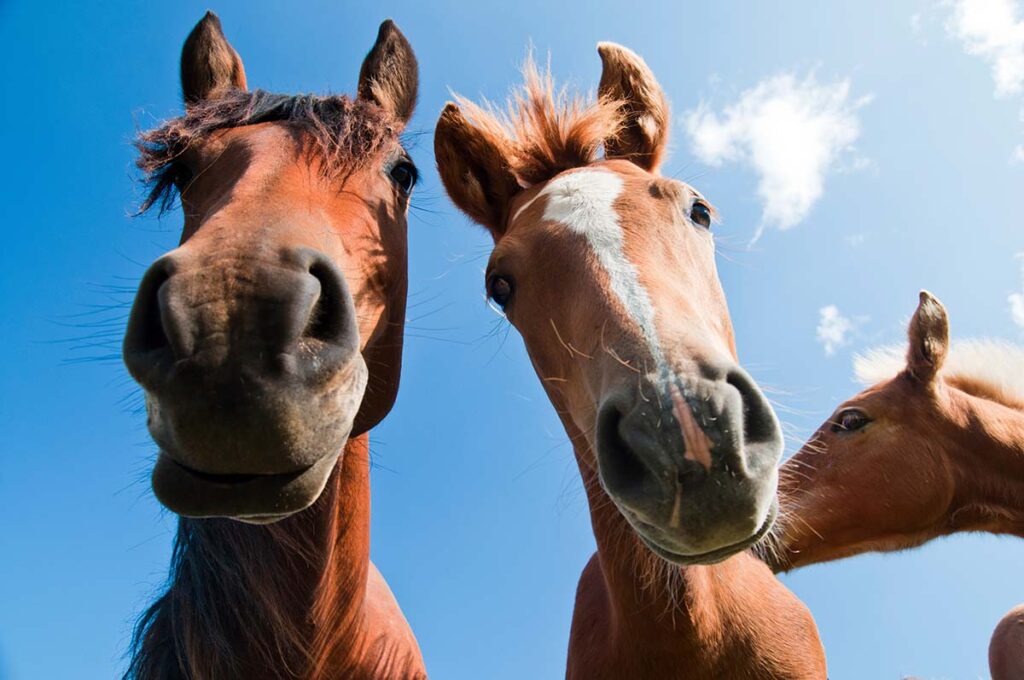If you’re not a builder or a handyman, looking into a fully stocked toolbox can be daunting. How is that screwdriver different from this one? What does that thing do? Which tool do I use to fix this problem?
The same can be said for a non-horse person or a novice equestrian looking into a well-equipped grooming box. What does that brush with the flexible points do? Which implement do I use first? What on earth do I do with that metal device?
Don’t worry. If you’re wondering how to groom a horse the right way, we’re here to help. Here’s a look at the grooming tools you’ll need and how to use them.
How To Groom Your Horse, Step 1: Curry comb
Start grooming with your curry comb, which is a rubber or plastic (or, less commonly, metal) tool with rows of small teeth. It can be round, oval, or mitt-shaped and is designed to help dislodge mud, dirt, and debris from your horse’s coat. Move the curry comb over your horse’s body in a circular motion. How much pressure you’ll need to apply depends on several factors, including how dirty or sensitive-skinned your horse is. If the horse is relatively clean or has very sensitive skin, only apply gentle pressure (just enough to bring dirt, grime, and dust to the surface). For a coat matted with mud or dried sweat, you’ll need to use more elbow grease to get the coat loosened up and debris out.
Avoid using curry combs too heavily, especially metal ones, below the knees or hocks, around the horse’s eyes, on bony protuberances, or in areas the horse is thin-skinned. Doing so could cause pain or irritation.
Also, pause frequently to clean out your curry comb. One that’s accumulated too much dead hair and dirt won’t be as effective as a clean one.
Step 2: Body (hard) brush
Next, reach for your body (sometimes called hard) brush—its stiff bristles will help brush the dirt and debris you removed with the curry comb off the horse. Start at the top of your horse’s neck near his ears and move toward the tail and downward toward the hooves. Run the brush over the body in straight lines, the direction of the hair growth, and “flick” the dirt and grime away at the end of each stroke.
Even if your horse doesn’t have sensitive skin, brush gently on the lower legs, head, and other thin-skinned areas. If your horse does have sensitive skin, use care when brushing the entire body. If he flinches or looks uncomfortable with the body brush, consider using a soft brush instead.


Step 3: Soft brush
Now we’re moving from the “cleanup” phase to the “polishing” one. The soft brush doesn’t loosen or remove big chunks of dirt and debris. Rather, it sweeps the finer dust and particles off the horse’s coat. As with the body brush, use short, flicking strokes to remove debris.
Step 4: Hoof pick
Turn your attention to your horse’s hooves. Using a hoof pick (a tool with a metal hook), start cleaning out any rocks, dirt, or other debris from around the frog (the fleshy “triangle” on the bottom of the foot). If your horse is wearing shoes, trace around the inside of the shoe to check for and remove any pebbles. For a barefoot horse, clean around the area where the hoof sole (bottom of the hoof) meets the hoof wall (the outer hoof capsule).
Cleaning your horse’s hooves can also help prevent a foul-smelling infection called thrush from developing and allows you to inspect the hoof for abnormalities or punctures before they turn into serious issues.


Step 5: Mane and tail brush or comb (or your fingers)
Work with your horse’s mane and tail carefully, particularly if they’re tangled. Consider using a detangling spray or gel (designed for horses and available from most tack shops) to help gently sort out knots and snarls without pulling hair out. Start from the bottom of the mane and/or tail and work up, applying detangler as needed. Many horse owners use a wide-toothed comb or brush, while others prefer to work through a horse’s mane and tail using their fingers.
When brushing the tail, don’t brush the whole thing at once. Pick up a small handful of tail with one hand, pull it aside, brush it gently, then move on to the next section. The more frequently you groom a horse’s mane and tail, the less time it will take and the fewer tangles you’ll have to contend with. If it’s not tangled, however, many horse owners leave the tail alone to prevent it from thinning.
Step 6: Grooming cloth or rag
Finally, take a clean rag and wipe it over your horse’s body. This will remove the final bits of dust and debris left behind from the soft brush and/or mane and tail. You can also use a cloth to clean around the eyes or ears where a brush isn’t appropriate.


The Finished Product
Once you’ve finished grooming, step back and admire your efforts. Remember to work safely around your horse at all times, and watch closely for any issues or abnormalities.








